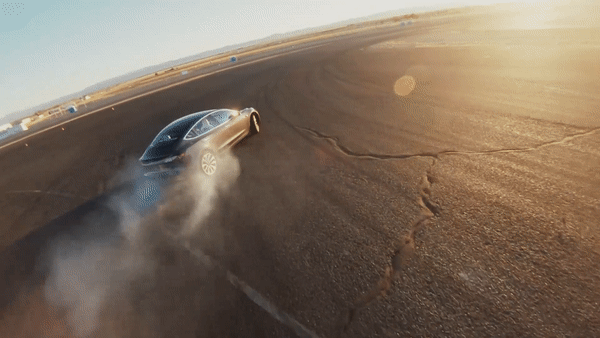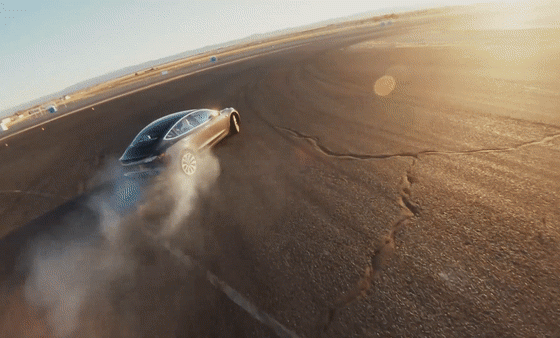Tesla has announced that it is starting the rollout of Track Mode, a feature of the Model 3 Performance that allows the car to perform better on a racecourse, today. In light of the feature’s release, Tesla has published a blog post outlining the science behind Track Mode, as well as the feature’s specifics.
While Tesla’s other performance-oriented upgrades like Ludicrous Mode for the Model S and X help a vehicle with straight-line acceleration, Track Mode helps the company’s electric cars handle corners better. Tesla’s blog post notes that Track Mode was designed specifically to be used on closed autocross circuits and racetracks. The company also pointed out that its goal behind the development of Track Mode was simple — they wanted to use the power of the vehicle’s electric motor and instant torque to “make cornering on the track feel just as natural as forward acceleration.”
Track Mode enables vehicles to precisely control whether torque goes to the front or the rear wheels. This allows the Model 3 Performance to instantly increase or decrease the car’s rotation in a corner. With such a system in place, racing enthusiasts would find that highly technical driving sessions on a closed circuit would be a lot easier.
Track Mode starts rolling out today
— Tesla (@Tesla) November 8, 2018
Unlike the usual Sport Modes of legacy carmakers, which usually involve the disabling of stability control, the Model 3 Performance’s Track Mode adds features to the vehicle. Tesla accomplished this by replacing the electric car’s stability control system with its own Vehicle Dynamics Controller — a software specifically developed for the company’s electric vehicles that acts as both a stability control system and a performance enhancement on the track. Tesla also provided a summary of the features that are employed by Track Mode when it is activated.
Motor Torque for Rotation
Our Vehicle Dynamics Controller continually monitors the state of the vehicle and all of the inputs from the driver to determine the driver’s intention and affect the rotation of the car in a matter of milliseconds. Track Mode relies heavily on the front and rear motors to control the car’s rotation, and we have the ability to command a 100% torque bias. When cornering, if rotation is insufficient to the driver’s request, the system controls a rear biased torque. Conversely, when rotation is excessive, we command a front biased torque.
Increased Regenerative Braking
Heavy regenerative braking may not be comfortable for day-to-day driving, but on a track, it has several key advantages. It gives the driver more authority with a single pedal, improves the endurance of the braking system, and sends more energy back into the battery, maximizing the battery’s ability to deliver large amounts of power. It also gives the Vehicle Dynamics Controller more authority to create or arrest rotation with the motors when your foot is lifted off of the accelerator pedal.
Track Focused Powertrain Cooling
The high output power required for track driving generates a lot of heat, so endurance on the track requires more aggressive cooling of the powertrain. We proactively drop the temperatures of the battery and the drive units in preparation for the track and continue to cool them down in between drive sessions. We can also allow operation of the powertrain beyond typical thermal limits and increase our refrigerant system capacity by overclocking the AC compressor into higher speed ranges.
Enhanced Cornering Power
We typically think of using brakes to slow down a car, but you can actually use them to make the car faster out of a corner. All Model 3s are equipped with open differentials, which send an equal amount of torque from the motors to both the left and right wheels. When cornering, the wheels on the inside of the corner have less load on them, which means they can provide less tractive force than the outside wheels. To prevent excess slip on this inside tire, we have to limit the torque for both wheels, leaving power on the table. In Track Mode, we simultaneously apply brake and motor torque to produce a net increase in tractive force while cornering. This is similar to how a limited slip differential works, except when using the brakes, the differential can be optimized for various driving conditions.
What is particularly exciting about the release of Track Mode is the fact that it is just the first version of the system. On its blog post, Tesla noted that Track Mode is set to improve further in the future through over-the-air updates.
When Elon Musk announced the Model 3 Performance on Twitter, he noted that the vehicle would be around 15% faster than a BMW M3 on the track. Considering the pedigree of the German-made performance sedan as well as the tendency of Tesla’s previous vehicles to throttle their performance on a track, Musk’s claims were met with a notable degree of skepticism from both avid car enthusiasts and critics alike. That said, initial reviews of the feature were notably positive.
Tesla conquered the drag strip with Ludicrous Mode. It remains to be seen if the company can do the same on the closed circuit with Track Mode. Considering the deliberate design of the feature, though, there is a pretty good chance that the Model 3 Performance would soon be just as formidable on the track as the Model S P100D is on the drag strip.

News
Tesla FSD fleet is nearing 7 billion total miles, including 2.5 billion city miles
As can be seen on Tesla’s official FSD webpage, vehicles equipped with the system have now navigated over 6.99 billion miles.

Tesla’s Full Self-Driving (Supervised) fleet is closing in on almost 7 billion total miles driven, as per data posted by the company on its official FSD webpage.
These figures hint at the massive scale of data fueling Tesla’s rapid FSD improvements, which have been quite notable as of late.
FSD mileage milestones
As can be seen on Tesla’s official FSD webpage, vehicles equipped with the system have now navigated over 6.99 billion miles. Tesla owner and avid FSD tester Whole Mars Catalog also shared a screenshot indicating that from the nearly 7 billion miles traveled by the FSD fleet, more than 2.5 billion miles were driven inside cities.
City miles are particularly valuable for complex urban scenarios like unprotected turns, pedestrian interactions, and traffic lights. This is also the difference-maker for FSD, as only complex solutions, such as Waymo’s self-driving taxis, operate similarly on inner-city streets. And even then, incidents such as the San Francisco blackouts have proven challenging for sensor-rich vehicles like Waymos.
Tesla’s data edge
Tesla has a number of advantages in the autonomous vehicle sector, one of which is the size of its fleet and the number of vehicles training FSD on real-world roads. Tesla’s nearly 7 billion FSD miles then allow the company to roll out updates that make its vehicles behave like they are being driven by experienced drivers, even if they are operating on their own.
So notable are Tesla’s improvements to FSD that NVIDIA Director of Robotics Jim Fan, after experiencing FSD v14, noted that the system is the first AI that passes what he described as a “Physical Turing Test.”
“Despite knowing exactly how robot learning works, I still find it magical watching the steering wheel turn by itself. First it feels surreal, next it becomes routine. Then, like the smartphone, taking it away actively hurts. This is how humanity gets rewired and glued to god-like technologies,” Fan wrote in a post on X.
News
Tesla starts showing how FSD will change lives in Europe
Local officials tested the system on narrow country roads and were impressed by FSD’s smooth, human-like driving, with some calling the service a game-changer for everyday life in areas that are far from urban centers.

Tesla has launched Europe’s first public shuttle service using Full Self-Driving (Supervised) in the rural Eifelkreis Bitburg-Prüm region of Germany, demonstrating how the technology can restore independence and mobility for people who struggle with limited transport options.
Local officials tested the system on narrow country roads and were impressed by FSD’s smooth, human-like driving, with some calling the service a game-changer for everyday life in areas that are far from urban centers.
Officials see real impact on rural residents
Arzfeld Mayor Johannes Kuhl and District Administrator Andreas Kruppert personally tested the Tesla shuttle service. This allowed them to see just how well FSD navigated winding lanes and rural roads confidently. Kruppert said, “Autonomous driving sounds like science fiction to many, but we simply see here that it works totally well in rural regions too.” Kuhl, for his part, also noted that FSD “feels like a very experienced driver.”
The pilot complements the area’s “Citizen Bus” program, which provides on-demand rides for elderly residents who can no longer drive themselves. Tesla Europe shared a video of a demonstration of the service, highlighting how FSD gives people their freedom back, even in places where public transport is not as prevalent.
What the Ministry for Economic Affairs and Transport says
Rhineland-Palatinate’s Minister Daniela Schmitt supported the project, praising the collaboration that made this “first of its kind in Europe” possible. As per the ministry, the rural rollout for the service shows FSD’s potential beyond major cities, and it delivers tangible benefits like grocery runs, doctor visits, and social connections for isolated residents.
“Reliable and flexible mobility is especially vital in rural areas. With the launch of a shuttle service using self-driving vehicles (FSD supervised) by Tesla in the Eifelkreis Bitburg-Prüm, an innovative pilot project is now getting underway that complements local community bus services. It is the first project of its kind in Europe.
“The result is a real gain for rural mobility: greater accessibility, more flexibility and tangible benefits for everyday life. A strong signal for innovation, cooperation and future-oriented mobility beyond urban centers,” the ministry wrote in a LinkedIn post.
News
Tesla China quietly posts Robotaxi-related job listing
Tesla China is currently seeking a Low Voltage Electrical Engineer to work on circuit board design for the company’s autonomous vehicles.

Tesla has posted a new job listing in Shanghai explicitly tied to its Robotaxi program, fueling speculation that the company is preparing to launch its dedicated autonomous ride-hailing service in China.
As noted in the listing, Tesla China is currently seeking a Low Voltage Electrical Engineer to work on circuit board design for the company’s autonomous vehicles.
Robotaxi-specific role
The listing, which was shared on social media platform X by industry watcher @tslaming, suggested that Tesla China is looking to fill the role urgently. The job listing itself specifically mentions that the person hired for the role will be working on the Low Voltage Hardware team, which would design the circuit boards that would serve as the nervous system of the Robotaxi.
Key tasks for the role, as indicated in the job listing, include collaboration with PCB layout, firmware, mechanical, program management, and validation teams, among other responsibilities. The role is based in Shanghai.
China Robotaxi launch
China represents a massive potential market for robotaxis, with its dense urban centers and supportive policies in select cities. Tesla has limited permission to roll out FSD in the country, though despite this, its vehicles have been hailed as among the best in the market when it comes to autonomous features. So far, at least, it appears that China supports Tesla’s FSD and Robotaxi rollout.
This was hinted at in November, when Tesla brought the Cybercab to the 8th China International Import Expo (CIIE) in Shanghai, marking the first time that the autonomous two-seater was brought to the Asia-Pacific region. The vehicle, despite not having a release date in China, received a significant amount of interest among the event’s attendees.










